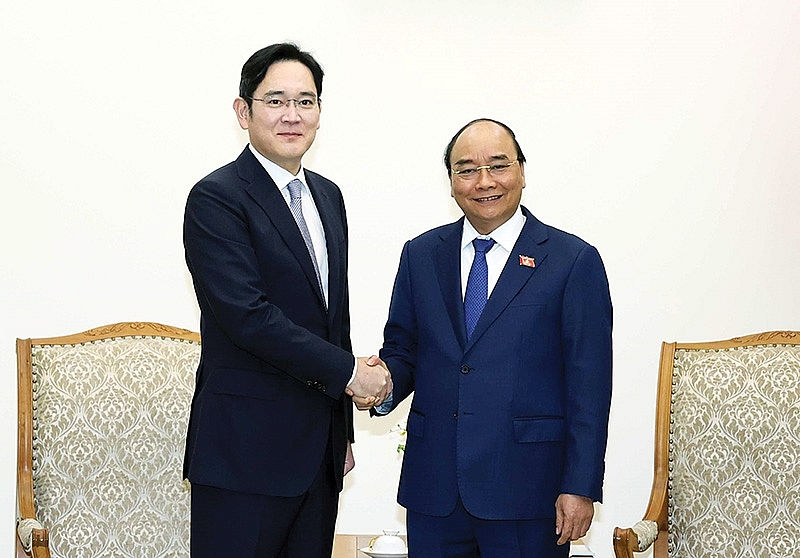Vietnam’s significance conveyed by Samsung
 |
| Prime Minister Nguyen Xuan Phuc (right) met with Lee Jae Yong, vice chairman of Samsung Electronics. Photo: VNA |
At last week’s meeting in Hanoi between Prime Minister Nguyen Xuan Phuc and Samsung Electronics vice chairman Lee Jae Yong, they were reported to have discussed a rise in investment related to battery and smartphone manufacturing, and Samsung SDI reportedly may announce a plan to build an electric vehicle battery manufacturing plant in Vietnam.
Currently, Samsung SDI has no such lines in Vietnam although it has local assembly lines for mobile phone battery assembly and supply to Samsung Electronics Vietnam.
Yong also inspected Samsung’s facilities in the northern provinces of Bac Ninh and Thai Nguyen, and Ho Chi Minh City. He said that the business situation for Samsung Vietnam is still facing challenges amid the pandemic.
In recent weeks, Vietnam has decided to allow entry for more than 3,000 Samsung engineers and experts in order for the company to operate factories smoothly. According to Yong, if the factories in Vietnam cannot operate as planned, Samsung’s entire global production chain would be disrupted.
The invited engineers are also needed for the company’s research and development (R&D) centre, which will be put into operation at the end of the year. The centre will be the group’s main R&D base, employing more than 3,000 engineers and illustrating Samsung’s efforts in not only investing in manufacturing but also R&D activities in Vietnam while cooperating with domestic businesses in software development.
At the meeting with PM Phuc, Yong expressed wishes that the Vietnamese government would continue to create favourable conditions for Samsung and its partners, while PM Phuc expressed his hopes that the company would make an investment in a semiconductor plant in the country.
Currently Samsung has invested about $17 billion into Vietnam with different projects producing electronics products, especially smartphones.
Meanwhile, competitors like Apple are seeing its production outputs stagnate amid the pandemic’s effects in China. Samsung, on the other hand, is benefiting from the very limited impact on its operations in Vietnam. While investing in developing a smartphone facility in the country, Samsung has actively increased output through more affordable labour costs and incentives from the government.
Together with Samsung, a series of South Korean suppliers also came to Vietnam, resulting in the sector’s impressive growth, with nearly half of Samsung’s smartphones now being manufactured in the Southeast Asian nation. With this setup, Samsung is in a much better position than its competitors.
Samsung’s ceded most of the Chinese market to competitors in recent years, which has helped the company mitigate the impact of the market’s declining demand – which is still affecting other manufacturers of smartphones with factories in China. In 2019, Samsung ended its smartphone production in China as its market share fell to nearly zero.
However, the import of large quantities of components from China could also have a negative impact on Samsung, especially if the pandemic continues to go on. Samsung depends on Chinese contractors for certain low-end phone components, and may also have problems in production due to a lack of basic elements like semiconductors imported from Japan.
Import of the above materials from Japan accounts for more than 90 per cent of Samsung’s total supply, and a possible replacement of semiconductors from this nation with domestic products remains unstable.
What the stars mean:
★ Poor ★ ★ Promising ★★★ Good ★★★★ Very good ★★★★★ Exceptional
Related Contents
Latest News
More News
- Global partnerships key to Vietnam’s IFC development (December 26, 2025 | 16:18)
- Vingroup pulls out of bid to invest in North-South high-speed railway (December 26, 2025 | 11:42)
- Strengthening supply chains through trade promotions and customs reform (December 24, 2025 | 14:00)
- PM orders investment model for North–South high-speed rail (December 22, 2025 | 17:43)
- LS Eco Energy to invest in Vietnam rare earth sector (December 22, 2025 | 17:31)
- Government moves to establish International Financial Centre (December 21, 2025 | 21:00)
- Vietnam's IFC to target global investment flows (December 21, 2025 | 18:00)
- Two national hospitals expand capacity with new facilities (December 20, 2025 | 09:00)
- Ha Tinh breaks ground on major Vingroup industrial and energy projects (December 19, 2025 | 18:24)
- EVN launches major power infrastructure projects nationwide (December 19, 2025 | 18:17)

 Tag:
Tag:





















 Mobile Version
Mobile Version